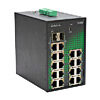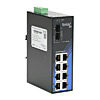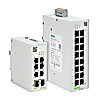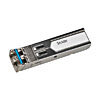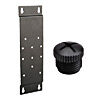As the use of industrial Ethernet devices increases, network security, segment isolation, and packet priority control become increasingly difficult when using unmanaged switches. This is where a managed switch becomes especially beneficial in an industrial network application. With a STRIDE layer 2 managed Ethernet switch, networks can be configured using the convenient web-based configuration interface and managed in a way that assures the highest performance levels for your applications.
STRIDE Layer 2 Managed Switches feature:
- Modbus TCP & EtherNet/IP management:
Diagnostic status and management access are available through Modbus TCP/UDP or EtherNet/IP. Use either of these protocols to monitor network health or make changes to the network configuration. - Network security:
The STRIDE managed switches have several security features that help to support a secure network strategy including port control (disables unused ports) and remote access security - Redundancy protocols:
In addition to STP and RSTP, STRIDE managed switches support redundant ring technology to keep the network running even under fault conditions. - Enhanced traffic filtering:
- Multicast Filtering (IGMP): STRIDE managed switches can intelligently 'learn' whether certain Multicast packets should be sent to the devices on its ports and will filter them or not filter them appropriately.
- Traffic Priority (QoS/CoS): STRIDE switch can apply tags to a packet coming into the switch to give that packet a higher priority going to another switch.
- VLAN Support: A VLAN is a logical way to separate networks through software instead of physically relocating devices or connections and allows for devices to be grouped together even if they are not located on the same network switch.
- Troubleshooting tools:
With the Port Mirroring feature you simply specify which ports' data you want to view and where to send that data. Using Ethernet sniffing software you can monitor the data being sent back and forth.
Network statistics lists the type of packets coming in and out of the switch so you can determine what action needs to be taken to make your network perform better.

 Loading...
Loading...
 Cookies are not enabled on your browser.
Cookies are not enabled on your browser.